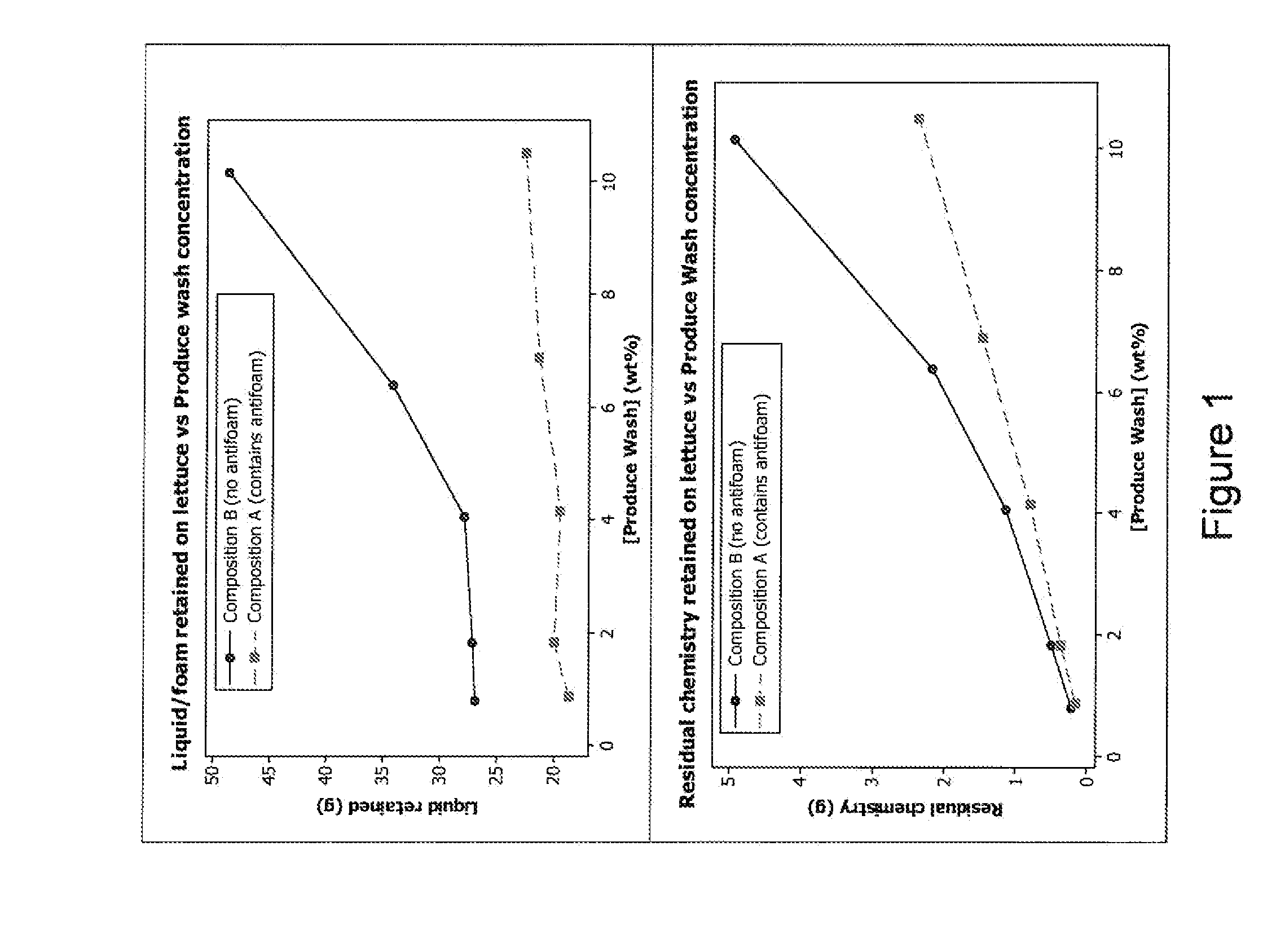Rheology modified low foaming liquid antimicrobial compositions and methods of use thereof
a technology of antimicrobial compositions and liquids, applied in the field of rheology modified low foaming liquid antimicrobial compositions, can solve the problems of food unsuitable for consumption, consumer perception of a lower quality product, regulatory investigations and sanctions, illness or death, etc., and achieve the effect of reducing the number of microorganisms
- Summary
- Abstract
- Description
- Claims
- Application Information
AI Technical Summary
Benefits of technology
Problems solved by technology
Method used
Image
Examples
example 1
[0101]A test was performed to evaluate the impact of the addition of a defoaming agent to an exemplary produce wash formulation. Three formulations were tested. Compositions A and B were prepared in accordance with embodiments of the present disclosure. Compositions A and B are shown in the table below.
AgentComposition AComposition BAnionic Surfactant6.846.84C5-C11 Carboxylic1.001.00AcidDefoaming Agent0.500.00Lactic Acid19.6519.65Thickening Agent0.400.40Processing Aid1.201.20Stabilizing Agent0.640.64Miscellaneous0.0550.055DI WaterTo 100To 100
Composition A also included a defoaming agent. Composition B included the same antimicrobial composition as included in Composition A, but did not include a defoaming agent. Comparative Composition 1 included a commercially available produce wash, Fit® Fruit and Produce Wash, commercially available from HealthPro Brands, Inc.
[0102]Each composition was diluted to a ratio of 1 ounce of produce wash to 1 gallon of water (5 grain). Then 40 millilite...
example 2
[0104]A study using Compositions A and B, as described above in Example 1, was run to evaluate the carryover of residual chemistry onto lettuce as a function of the foam level and the concentration of various produce washes in accordance with the present invention.
[0105]For this study, Dole brand cut and prepackaged romaine lettuce hearts were used. The lettuce was weighed and placed in a strainer and the vessel was filled with six liters (L) of either Composition A or B. The compositions were dispensed into the vessel using an Oasis® Cleaning System, commercially available from Ecolab Inc. The dispense time was 35 seconds, at a flow rate of approximately 10.3 liters / minute.
[0106]Thirty seconds after the composition was applied, a picture was taken of the foam and the strainer was removed from the liquid. The strainer was allowed to drain for 30 seconds and another photo was taken to visually document the amount of foam present. The lettuce was then transferred by hand to a plastic ...
example 3
[0109]A study was performed to measure the ability of an antimicrobial produce wash composition in accordance with embodiments of the present disclosure to reduce Listeria monocytogenes, Escherichia coli O157:H7 and Salmonella enterica in processing waters for fruit and vegetables. The formula of the produce wash is also shown in the table below.
TABLE 3Produce WashCompositionAmount (weight %)DI Water67.95Anionic Surfactant1.37Combination of26.32AcidulantsStabilizing Agent3.06Thickening Agent0.70Defoaming agent0.60
[0110]The produce wash composition was tested against three different test systems. Test System 1 included a Listeria monocytogenes mixture that included: L. monocytogenes ATCC 49594, L. monocytogenes ATCC 19114, and L. monocytogenes ATCC 19116. Test System 2 included a Escherichia coli O157:H7 mixture that included E. coli O157:H7 ATCC 43895, E. coli O157:H7 ATCC 35150, and E. coli O157:H7 ATCC 43890. Test System 3 included a Salmonella enterica mixture that included S. en...
PUM
| Property | Measurement | Unit |
|---|---|---|
| Temperature | aaaaa | aaaaa |
| Fraction | aaaaa | aaaaa |
| Time | aaaaa | aaaaa |
Abstract
Description
Claims
Application Information
 Login to View More
Login to View More - R&D
- Intellectual Property
- Life Sciences
- Materials
- Tech Scout
- Unparalleled Data Quality
- Higher Quality Content
- 60% Fewer Hallucinations
Browse by: Latest US Patents, China's latest patents, Technical Efficacy Thesaurus, Application Domain, Technology Topic, Popular Technical Reports.
© 2025 PatSnap. All rights reserved.Legal|Privacy policy|Modern Slavery Act Transparency Statement|Sitemap|About US| Contact US: help@patsnap.com

